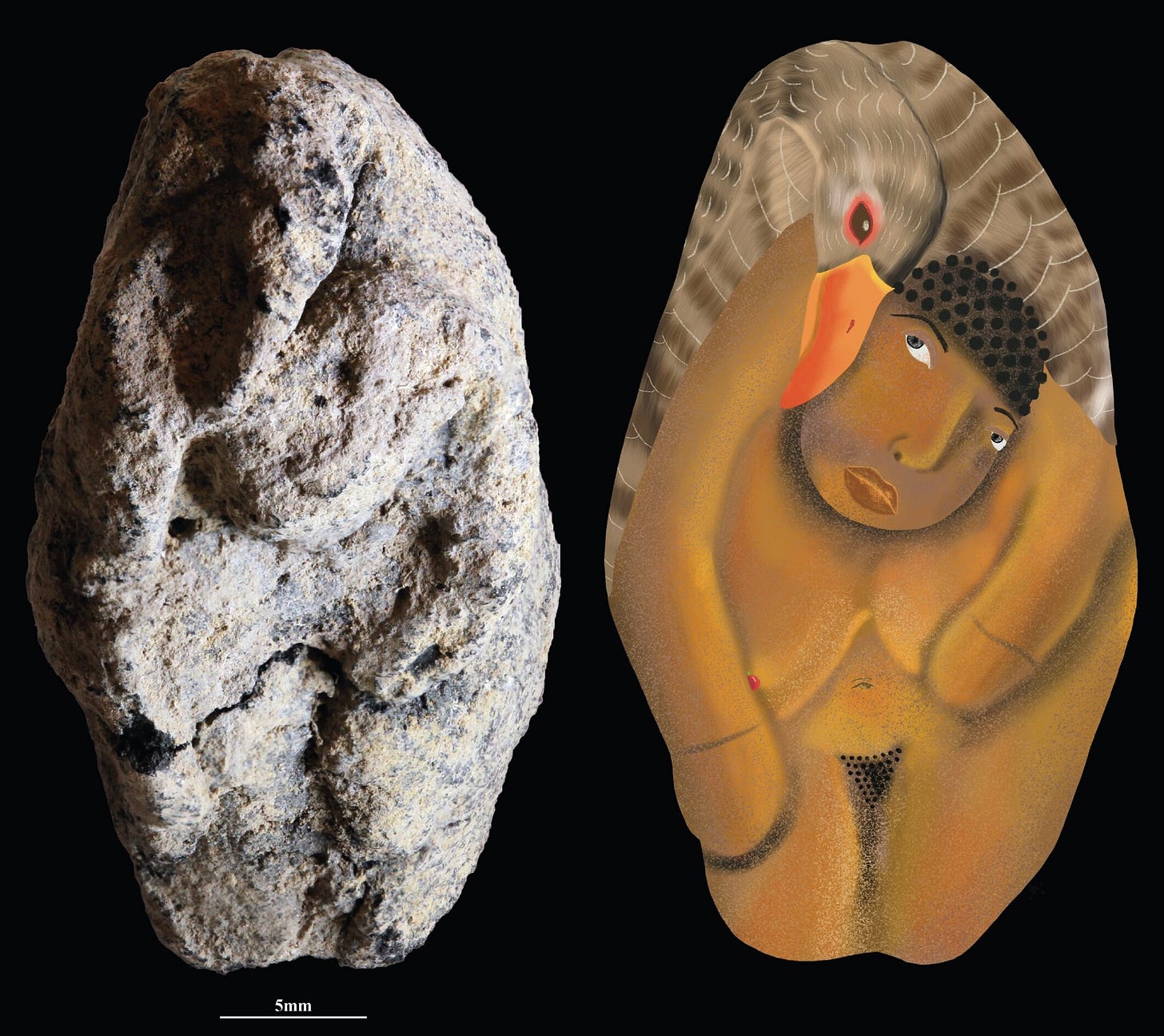🧐 Ancient Beat #174: Prehistoric stories, human grammar, and apes making out
Oh, hey. This is issue #174 of Ancient Beat. Welcome.
If you’ve been on the fence about upgrading to get all the latest discoveries each week, here’s 35% off. Sort of an early-bird Black Friday. Next week, it’ll be 20%. Then back to normal.
And if you’re getting ready for the holidays, please consider this: Give the gift of nerding out (over and over again for a year)!
Without further ado, here’s the latest ancient news. 👇
🗞 Ancient News: Top 5
Clay, Shadows, And The First Stories We Told — A small clay figurine from a Late Natufian site overlooking the Sea of Galilee, dated to around 10,000 BCE, depicts a crouching woman with a goose perched against her back. The piece stands out as one of the earliest known human-animal narrative scenes in Southwest Asia and one of the region’s earliest naturalistic portrayals of a woman. The figure’s posture and the bird’s enveloping position hint at symbolic or mythic storytelling rather than simple decoration. Unlike the typically abstract or geometric imagery of the Natufian period, this figurine shows expressive modeling and intentional narrative composition. Its creation in soft clay also highlights early experimentation with representational art as communities were transitioning from mobile lifeways toward more settled Neolithic patterns. No other artifacts of similar detail from this period have been found at the site, making this object an unusually vivid glimpse into early storytelling and human-animal symbolism.
Patterns Beneath The Noise: What A Massive Global Dataset Is Teaching Us About The Deep Structure Of Human Grammar — A large computational analysis of more than 1,700 languages tested 191 proposed grammatical “universals” to see which patterns genuinely recur across humanity. Using a global linguistic dataset, the study accounts for shared ancestry, geographic proximity, and long-term borrowing to avoid treating languages as independent points of data. Roughly one-third of the proposed universals—such as tendencies in word order or how subjects are marked—show strong statistical support. Another third fall into a gray zone, and the final third collapse once lineage and diffusion effects are controlled for. The work suggests that some structural similarities between far-flung languages emerge not by accident but as stable outcomes of how humans encode meaning and manage information. At the same time, the results show that global grammar is neither random nor uniform: grammatical patterns propagate through a mix of cognitive constraints, inheritance, contact, and historical drift. The findings offer a more grounded picture of what features may reflect deep human tendencies versus those that spread through cultural history.
Ancient DNA Shows Dogs and People Migrated Together Across Eurasia — Analysis of 73 ancient dog genomes (including 17 newly sequenced) shows that dogs were traveling alongside human populations across Eurasia for at least 10,000 years. The genetic data reveal that distinct “Eastern” and “Western” dog lineages diverged over 20,000 years ago, and these lineages moved, mixed or replaced one another in lockstep with known human migrations. Regions studied include Europe, Eastern Siberia and the Eurasian Steppe. Dogs weren’t passive companions: their dispersals mirror major cultural-shifts (hunter-gatherer to farmer to pastoralist), and in some cases dogs exchanged between communities even when human ancestries didn’t, suggesting dogs also circulated as valued material or social assets.
The Ape Kiss: What a New Comparative Study Reveals About the Ancient Roots of Mouth-to-Mouth Affection — A comparative study across large apes (gorillas, chimpanzees, orangutans) and humans posits that the behavior of mouth-to-mouth contact (AKA smooching) has deep evolutionary roots, likely emerging around 16 to 21 million years ago in the great-ape lineage. Far from being a purely human cultural quirk, the gesture appears as a social tool inherited by Homo neanderthalensis and other Homo species. The research reframes affection, reconciliation or alliance behaviors in primates as part of a shared evolutionary heritage, rather than purely modern cultural invention. I covered another paper on kissing a couple of years back, and at that point, we had only traced it back a few thousand years.
Imagery from 4000-Year-Old Goblet Might Depict a Cosmic Creation Story — A small silver goblet dating to the Intermediate Bronze Age (c. 2200 BCE) found in the southern Levant is re-interpreted as possibly showing a cosmological narrative rather than a mythic struggle. One side apparently depicts a “chaotic” scene in which a nascent sun emerges above a serpent, while the reverse shows two anthropomorphic figures lifting a crescent-shaped vessel that cradles a fully formed sun, the serpent now subdued beneath. The imagery evokes the idea of the sun’s journey and the ordering of day/night and the annual cycle rather than battle between deities. The goblet thus may reflect an early visual schema of creation – a transition from chaos to cosmic order – long predating comparable mythic texts.
That’s it for the free Top 5! If you’re a free subscriber, sign up for the paid plan for another 31 discoveries and 3 recommended pieces of content covering everything from olive oil to lentils. Mmm.
Until next time, thanks for joining me!
-James
Twitter: @jamesofthedrum
P.S. Here’s my Buy Me A Coffee link if you’d like to support my efforts with a donation.
P.P.S. If you want access to the paid version but it’s a little too steep for you right now, just email me — I want this to be accessible.
P.P.P.S. Paid members, read on!
🗞 Ancient News: Deep Dive
Keep reading with a 7-day free trial
Subscribe to Ancient Beat to keep reading this post and get 7 days of free access to the full post archives.


